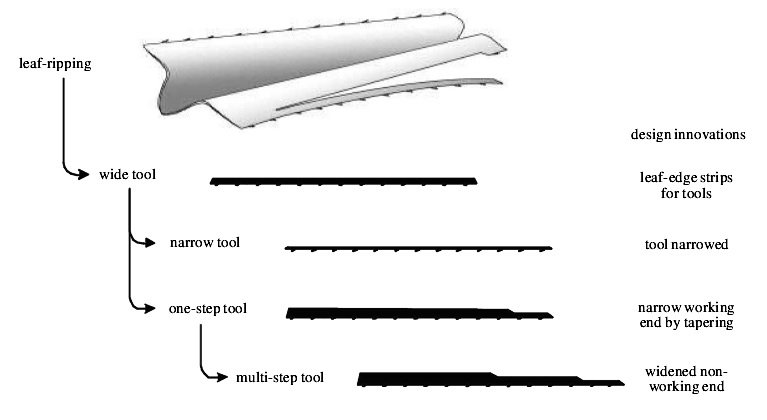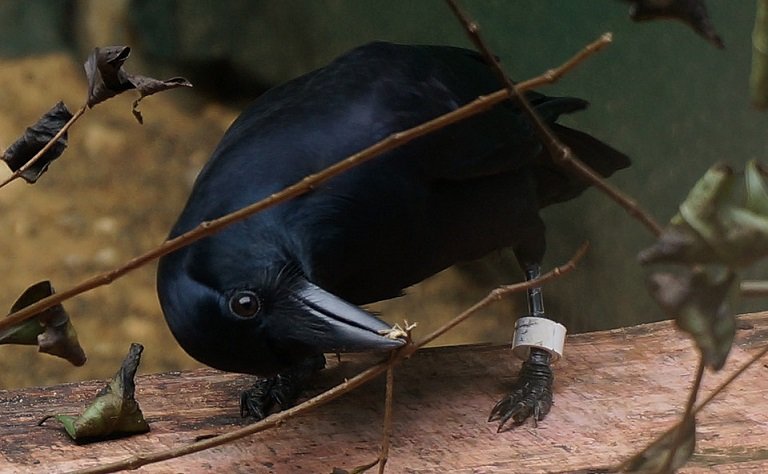What is a tool?
According to Goodall and van Lawick (1970) a tool is any object that serves as an extension of one's own body (essentially an extension of the upper limbs) that allows the individual to achieve goals and solve tasks that would not be possible to resolve using only the body. Osiurak et al. (2010) argues that there is a broad consensus for the characteristic features. First, the tools are discrete (and not formless) and unbound objects (either attached to the individual or the natural substrate) that (2) enables the user to enhance their sensorimotor functions, and (3) are limited to what is manipulated by the user.
The twigs used by the chimpanzees in the Gombe forest to fish termites with, is according to this definition tools, since they (1) are discrete items that are no longer bound to the vegetation, which (2) extends the hands of the chimpanzees and allows them to reach into the termite mound, and (3) the process doesn't include any external input or activity that is not under the user's manipulative control.
Matsuzawa (2011) developed what he calls the "tree structure analysis" to illustrate the hierarchical complexity that characterizes tool use. According to this analysis the example of termite fishing falls under subcategory "level 1", since only one object (a branch) is combined with the target. To crack nuts using a stone acting as the hammer, and another stone that serves as anvil falls under category "level 2", since the two independent objects are combined with the goal (Susi, 2006). The most complex type of tool use as reported in wild chimpanzees is the use of a stone that is used as a wedge to stabilize the anvil when the stone hammer on the nut, which shows the chimpanzees have an ability to understand physical causality, and this is categorized as "level 3" (Matsuzawa et al. 2011). Personally I see a possible weakness of this analysis method in that it simply categorizes complexity by the number of relationships, and not the quality of the performance itself.
How do the chimps learn the tool use?
In the movie clip with chimpanzees in Gombe (Goodall Institute, 2011) one could imagine that the first individual who learned to fish for termites with small leafless twigs, learned this through trial-and-error, ie. a process of attempting to reach a desirable goal by trying several different methods until success. This method may then have spread within the group, and further through the generations, through social learning processes, to eventually having become a group-specific cultural pattern.
Now tell me about those crows!
Another species that have demonstrated the ability to understand causation is the crow of New Caledonia, that manufacture and use several different types of tools. Among other things, they have been observed in the wild to carefully select twigs and leaves that are specifically suitable for the purpose, and then process them into functional tools to catch prey with. In experiments conducted by Weir et al. (2002 & 2006) a crow in captivity managed to perform a series of tasks that comprised of bending a metal wire, a completely new material for the test crow, into a hook in order to get hold of food. In another experiment (Taylor et al. 2009) the crows had to drop stones in water-filled tubes in order to get a reward to the surface. They did not spontaneously use stones as tools, but quickly learned, without a trial-and-error phase, to select objects and materials with the right properties only after having observed how the stones affected the water for a short period. They also showed a preference for heavy stones rather than light ones. The crows, however, didn't learn to distinguish between functional and non-functional objects and materials when there was an arbitrary rather than causal link between object and reward, suggesting that the performance of the crows can't be explained with associative learning. They do however seem to understand the "how" and "why". In addition, the level of complexity of the tools should be emphasized, as they seem remarkably more advanced than the fairly rudimentary and relatively crude tools of the chimpanzees.
Hunt & Gray (2003) argues that the tool-making of the Caledonian crows is an example of cumulative culture and what Tomasello calls ratchet effect, that is, that the tools are modified, developed and improved progressively over time and across generations; an effect that is not possible without culture or social learning. Without the existance of social groups, no transfer of knowledge is possible, including tool manufacture. We would be back to square one, so to speak, and would have to use trial-and-error to manufacture a stone ax. Whiten & Boesch (2001) claims that each generation would have to "reinvent the wheel" if it was not for cultural transmission. When it comes to the crows of New Caledonia Hunt & Gray (2003), refer to the cumulative development and diversification of pandanus leaves (see picture).

The evidence for this is still inadequate, and Kenward et al. (2006) points out that these crows seem to have an innate predisposition for tool use, which suggests that social learning is not necessary to explain certain aspects of their impressive tool use. Pearce (2008) argues that we need far more knowledge about how these crows acquire skills in the wild.
So, are the crows plotting world domination?
Both animals and humans use tools to help achieve goals, but despite the impressive examples of tool use in primates and corvids human tool use is more common, more sophisticated and more widely applied than in any other species. Man appears, as Osiurak et al. (2010) points out, to be the only species who “spontaneously and almost systematically use tools to modify their way of interacting with the world.” Furthermore, no other species than the human use tools to make other tools (Osiurak et al. 2010 & Wolpert, 2007). Hauser (2009) suggests that the main difference between humans and animals is that animal intelligence could be likened to a laser beam, in which a specific solution is used to solve a specific problem, but couldn't be applied to new situations and problems. Human cognition, he says, can rather be likened to a spotlight, allowing us to apply solutions for problems in many different situations. This, Hauser argues, is why the tools of humans have multiple functions, while it is difficult to find counterparts in the rest of the animal kingdom.
Sources:
Pearce, J.M. (2008) Animal learning & cognition: An introduction. Hove: Psychology Press.
van Lawick-Goodall, J. 1970. Tool-using in Primates and other Vertebrates. Advances in the Study of Behavior, vol. 3, edited by David S. Lehrman, Robert A. Hinde, and Evelyn Shaw. New York: Academic Press.
Osiurak, F., Jarry, C. & Le Gall, D. (2010). Grasping the affordances, understanding the reasoning: toward a dialectical theory of human tool use. Psychological Review, 117
Susi, T. (2006) The puzzle of social activity: The significance of tools in cognition and cooperation. Linköpings Universitet. ISBN 91-85523-71-2.
Matsuzawa, Tetsuro; Humle, Tatyana; Sugiyama, Yukimaru (2011) The Chimpanzees of Bossou and Nimba. Springer.
Taylor, A. H., Hunt, G. R., Medina, F. S. & Gray, R. D. (2009). Do New Caledonian crows solve physical problems through causal reasoning? Proc. R. Soc. Lond.
Weir, A.A.S., Chappell, J., & Kacelnik, A. (2002) Shaping of hooks in New Caledonian crows. Science
Weir, A.A.S., & Kacelnik, A. (2006) A New Caledonian crow (Corvus moneduloides) creatively re-designs tools by bending or unbending aluminium strips. Animal Cognition 9
Hunt, G.R., & Gray, R.D. (2003) Diversification and cumulative evolution in New Caledonian crow tool manufacture. Proceedings of the Royal Society of London
Kenward, B.,Rutz,C.,Weir,A.A.S.,&Kacelnik,A (2006) Development of tool use in New Caledonian crows: Inherited action patterns and social influence. Animal Behaviour
Whiten, A. & Boesch, C. (2001) The cultures of chimpanzees. Scientific American
Wolpert, L. (2007) Causal Belief Makes Us Human. i C. Pasternak, ed. What Makes Us Human? London: One World.
Hauser, M.D. (2007) Moral Minds: How Nature Designed Our Universal Sense of Right and Wrong. NY: Harper Collins



